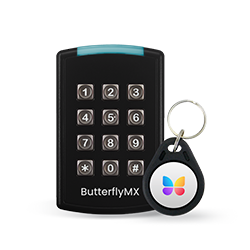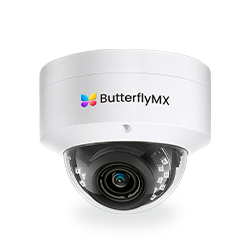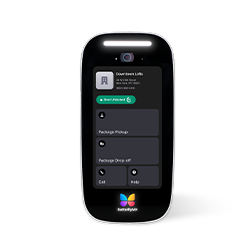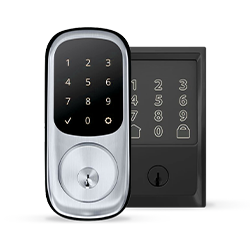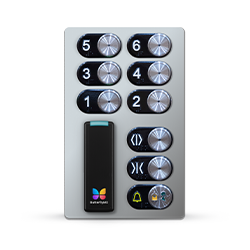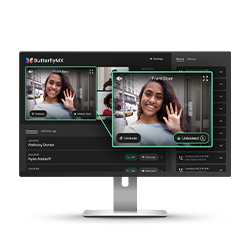Key takeaways
- An apartment call box connects visitors and residents at an apartment property. Visitors can alert residents from the front of the property when they arrive.
- Call boxes for apartments are bulkier than intercoms, which tend to be sleeker and more aesthetically pleasing.
- The best alternative to apartment call boxes is a modern video intercom that’s part of a comprehensive access control system.

As a property owner or manager, ensuring that access to your building is secure yet convenient is paramount. Residents, their visitors, and delivery couriers all need an apartment intercom system that accommodates their unique needs. For decades, apartment call boxes have been used to facilitate property access. But is a call box the best building entry system for your property?
This post explains an apartment call box and how it works. Then, we discuss call boxes’ limitations and offer a more robust alternative.
This post covers:
- What is an apartment call box?
- What is a call box?
- How does an apartment call box work?
- How do you use an apartment call box?
- How do you let someone in with an apartment call box?
- Types of apartment call boxes
- Limitations of call boxes
- 5 reasons why you should ditch your apartment call box
- Best alternatives to apartment call boxes
- Resident guide to apartment call boxes
- Call box FAQs
More than 40K, 5-star reviews!
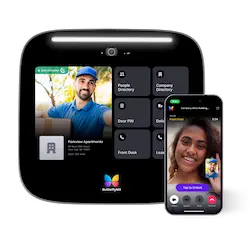
Video Intercoms
Open doors, gates & garages from anywhere.
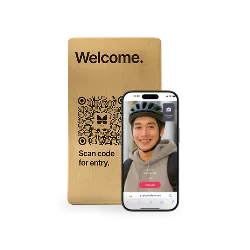
QR Code Intercom
Smartphone-based visitor access.
Access Control
Fob, key cards, PINs, and mobile apps.
Security Cameras
Visibility throughout your property.
Vehicle Access
Hands-free access for gates & garages.
Package Room
Receive, store, and manage deliveries.
Smart Locks
Connect to all major brands and models.
Elevator Controls
Unlock key-fobbed elevators for anyone.
Front Desk Station
See all your doors and cameras in one place.
What is an apartment call box?
An apartment call box connects visitors and residents at an apartment. With an apartment call box, residents can grant access to their visitors via a smartphone.
Apartment residents typically use call boxes to:
- Buzz in visitors without physically going to the front entrance.
- Open the door for delivery couriers.
- Manage visitor access without relying on a doorman or front desk.
While residents are the most obvious beneficiaries of call boxes, property staff also benefit from them. With a building call box, they don’t have time to grant visitors access.
Call boxes are usually installed at entrances to:
- Apartments
- Gated properties
- Offices
- Commercial buildings
- Industrial facilities
You can also use a call box for gate entry, in which case you would purchase a gate call box.
Sometimes called a telephone entry system or an intercom system, a front door call box consists of hardware at the entrance and hardware within each unit throughout the building. The system’s in-unit hardware could be a landline phone, a tenant’s cell phone, or a device with ‘listen’ and ‘talk’ buttons.
Apartment call boxes vs. other entry systems
While you might be familiar with the term apartment call box, residents and entry system providers use a wide range of terminology. So, what’s the relationship between a call box and other types of entry systems?
Multifamily building entry call boxes are comparable to:
- Telephone entry systems. You may refer to a call box as a telephone entry system or telephone call box if your system relies on a telephone line to make calls to your residents and notify them of their visitors.
- Buzzer systems. Call boxes are sometimes called door buzzers when the system uses in-unit hardware that makes a buzzing sound when a visitor calls a tenant.
How much does an apartment call box cost?
A building call box costs between $1,500 and $2,000. However, it would help if you also accounted for installation costs, which typically cost around $2,000.
What is a call box?
A call box is an access control device installed at a property entrance that allows visitors to contact and request access from someone in the building.
While they have limitations, door call boxes are one of the most widely used entry systems. They can be found on all multi-tenant properties and fitted for any door, gate, or garage.
Typically, call box entry systems include two pieces of hardware:
- Substations. Substations are the hardware residents use to communicate with visitors at the call box at the property’s entrance. Substations can take many shapes, from simple receivers that transmit audio to a mobile app on your tenants’ smartphones.
- Door strikes. Depending on the type of entrance, door strikes can take multiple forms, but they are often either electric or magnetic.
Is a call box the same as an intercom?
A call box is not the same as an intercom. While they operate the same way, these two devices are different. Usually, a call box is a bulkier, more heavy-duty piece of equipment created for outdoor use. Traditionally, intercoms are lighter-duty and designed for indoor use. However, modern intercom systems are designed to be sleek and fitted for outdoor use.
Watch how ButterflyMX works:
How does an apartment call box work?
Apartment call boxes send electrical signals from the device installed at the property’s entrance to a substation installed in the resident’s apartment. Depending on the technology powering your intercom call box, the signal travels from the base station call box to the resident’s substation in different ways.
Most door call boxes require wiring. If your call box is wired, signals travel from the call box to each substation along the same wiring that telephones use.
In contrast, wireless call boxes transmit signals via cellular networks, radio waves, or the Internet.
How do apartment gate call boxes work?
An apartment call box for a gate works similarly when located at the front entrance of an apartment building. First, the apartment call box is installed at a locked gate. When guests arrive at the gate on foot or in their car, they press the call button. Next, the resident answers and decides whether or not they want to open the gate by pressing the unlock button from their in-unit device or mobile phone. While you can integrate a gate opener with a call box, we recommend buying one with a gate opener for a more intuitive system.
How do you use an apartment call box?
Using a call box as a visitor is a relatively simple process.
Follow these steps to use an apartment call box:
- Start by finding the right tenant in the system’s directory.
- Once you’ve found the tenant, the call box will display a PIN code to dial that tenant.
- Enter that code using the call box’s keypad.
- You may have to press the # key or a call button to initiate the call.
- Alternatively, the call box may have a unique ‘call’ button for each tenant or unit. In that case, you must press the button labeled with the right unit number or tenant name.
- Once the tenant answers your call, you can speak to them through the call box’s microphone.
- When they open the door or gate for you, you’ll hear a buzzing sound alerting you that it’s unlocked.
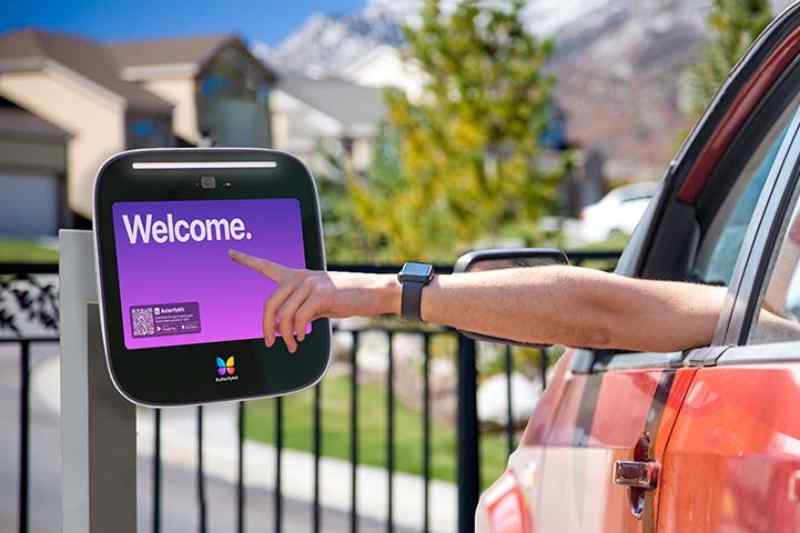
How do you let someone in with an apartment call box?
If you manage or live in an apartment with a front door call box, you’ll have to know how to answer visitors’ calls and let them in.
Letting someone in with an apartment call box is easy with these steps:
- The visitor uses the building call box to contact you.
- You’ll be notified in a few different ways depending on the kind of substation you have. If you’re using a telephone, you answer it just like a regular phone call. Otherwise, a door buzzer installed in your apartment unit may be the device alerting you of your visitor.
- The call box communicates with your substation either through building wiring or wirelessly. Both allow you and your visitor to communicate.
- You grant entry to your visitor. On the phone, you let someone in by pressing ‘9.’ If you have an in-unit buzzer device, you grant entry by pressing a ‘door open’ button.
Types of apartment call boxes
Now that you know how a call box for apartment buildings works and how to use one, you’re ready to dive into the different types of call boxes.
Some of the most popular types of call boxes for multifamily properties are:
Call box with camera
Some building entry system manufacturers now add cameras to their call boxes to allow residents to see their visitors. This offers the benefits of increased security and convenience since residents can see who’s requesting access before letting them in. But some buildings and gate call boxes with cameras have their downsides.
Traditional wired call boxes were originally designed to carry only audio. So, adding a camera to your current call box system requires several extensive modifications, like installing a separate camera system that must be managed separately.
Wireless call box
Most call boxes today are still wired. However, call box technology has always taken cues from advances in telephone technology. In the past, when wired telephones were popular, apartment call boxes were installed with similar wiring. But today, with the advent of wireless technologies like cell networks, WiFi, and high-speed internet, some residential call boxes are now wireless.
Wireless call boxes have several advantages over wired call boxes. For example, you’ll save on installation and maintenance when you don’t have any wiring to purchase, install, and maintain. But while they’re a step in the right direction, many wireless call boxes still don’t offer the modern features that building staff and residents need. For example, they fail to offer features like Delivery Passes for one-time or recurring property access for couriers.
IP call box
IP call boxes are a type of call box that uses the Internet to send communications. These call boxes can either use a wireless or wired internet connection. Wired IP call boxes typically use a CAT5/6 ethernet cord connected to a modem or switch to access the Internet. Wireless IP call boxes, on the other hand, use radio frequencies called spectrum. Spectrum is a broad term covering many technologies, including WiFi, Bluetooth, NFC, cellular, and radio waves.
The IP in ‘IP call box’ stands for Internet Protocol, a set of rules computers use to transmit data over the Internet. Another popular protocol is Voice over Internet Protocol (VoIP), so IP call boxes are also sometimes called VoIP call boxes.
Apartment call boxes with cell phones
In many call box apartment buildings, the call box connects to substations installed in every resident’s unit. However, these days, property managers can offer increased convenience and versatility by installing more sophisticated electronic call boxes that can call residents’ cell phones.
Using a cell phone as a substation instead of physically installing a substation panel has many benefits.
For one, building managers and owners save money. Installing a substation involves tearing up floors and ceilings and replacing them just to lay copper wiring. Wireless cell phones allow you to sidestep this process entirely.
Residents will surely appreciate the ability to open their doors from anywhere. With a cell phone-enabled apartment call box, residents will never have to miss a delivery or a visitor again.
Limitations of call boxes
Apartment building call boxes have saved a lot of time for residents. Property staff also benefit from apartment call boxes because they don’t have to spend time granting access to visitors. But what are the downsides of traditional call boxes?
There are significant limitations of apartment call boxes, including:
Not cloud-based
Call boxes don’t store their data in the cloud. As a result, your staff must manually update the system onsite instead of managing it remotely from any phone or laptop.
Further, if your apartment call box isn’t working, you may even need to install a computer server and hire an outside technician to update the call box.
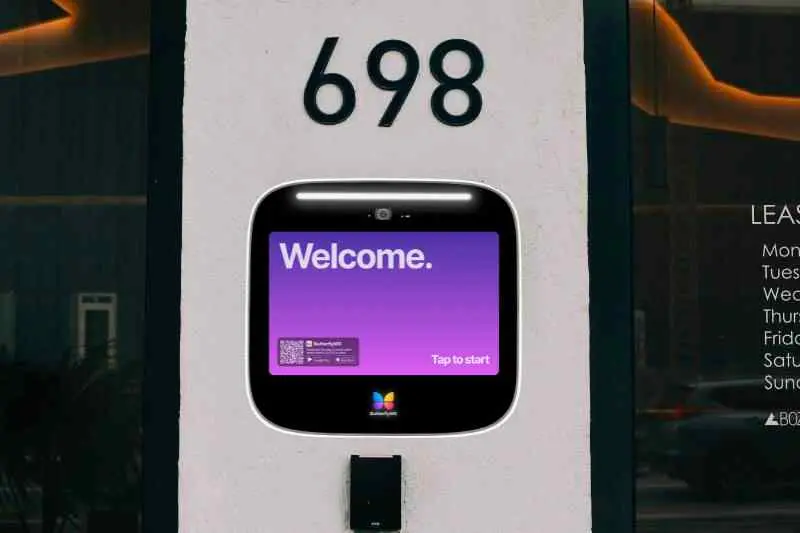
Fails to control access to other areas of your property
Managing access to your property’s front entrance is indeed important. But you know that keeping your residents satisfied means simplifying access for every area of your property. An intercom call box will still require separate access control systems, like keypads or key fobs if you want your residents to easily access other areas of your building.
No delivery-focused features
Today, your residents can order anything from food to furniture right to their doorstep. But traditional building call boxes don’t have tools that guarantee couriers’ property access. As a result, if a resident isn’t home or doesn’t answer their phone, they’ll miss their delivery.
In contrast, more modern intercom systems offer delivery PINs and passes to ensure successful deliveries every time.
5 reasons why you should ditch your apartment call box
Every multi-tenant building should have a door entry system, but a call box isn’t the best solution. There are better access control systems that offer improved functionality and enhanced features.
Here are the top five reasons why you should ditch your apartment call box:
- No video calling. Call boxes generally don’t have cameras, so they don’t enable video calling between tenants and visitors. This can create a security risk because residents can’t see who’s requesting property access.
- Difficult to install. Most door call boxes require you to run wiring throughout the entire building. And even cellular telephone entry systems — which operate over cell networks instead of wiring — require a separate cellular control box.
- No mobile app. Door call boxes don’t come with a mobile app. As a result, residents can’t remotely control access.
- Expensive to maintain. You’ll need a costly phone plan for your door call box. Additionally, you may have to pay a technician to manage and update your system.
- Inconvenient. Door call boxes don’t provide convenient property access. Most call boxes don’t offer features enabling residents to open the door for themselves. So, residents are stuck carrying keys, fobs, or keycards. Call boxes also don’t integrate with other proptech or access control devices.
Best alternatives to apartment call boxes
Many apartment call boxes don’t offer robust visitor management features for residential and commercial properties. So, if you’re considering a call box for your existing property or a new development, there are better entry solutions.
Look for an entry system that delivers a modern access experience designed for your residents’ lifestyles. After all, residents cite amenities that offer convenience and security as their highest priorities in an apartment, and an effective entry system can deliver both.
Here are the top three alternatives to an apartment call box:
- IP intercom: An IP intercom beats out the traditional door call box because it operates over the internet. As a result, it can transfer larger and more complex data, including video. Additionally, you won’t have to tear down walls or lay extensive wiring to install an IP intercom.
- Cloud-based access control system: Cloud-based access is ideal for any property because it empowers you to manage the system from anywhere. Hosting data in the cloud rather than maintaining a physical server onsite will cut costs.
- Video intercom: Most door call boxes don’t come with a camera, limiting your property’s security. Without a camera, your entry system doesn’t allow residents to confirm who requests access visually. But a video intercom system lets residents see their visitors before opening the door for them.
Video intercoms: Your most robust option
Apartment call boxes fulfill basic access control needs, but they’re outdated. Your residents deserve an entry system that uses all of today’s technology. To facilitate a flawless access experience, ditch your call box in favor of a modern video intercom.
Here are the top advantages of video intercoms:
- Guaranteed video communication. Unlike audio-only call boxes, video intercoms were designed to transmit audio and video simultaneously. With a video intercom, residents can see visitors before granting them access, which boosts security at your property.
- Cloud-based administration. Being able to manage a video intercom system from any device will save your staff a lot of time. Instead of manually inputting each resident into an apartment call box and manually removing that resident as they move out, a video intercom simplifies this process by putting the process online. The best video intercoms will even automate this process entirely by integrating with your property management software.
- Integrations. Residential call boxes aren’t technologically advanced enough to connect with the latest smart building technology. In contrast, video intercoms can seamlessly integrate with other hardware, like smart locks and thermostats.
ButterflyMX entry system
Video intercoms are the most comprehensive access control solution. And when it comes to security, convenience, and features, ButterflyMX is the best choice.
ButterflyMX offers a top-rated video intercom system with all the features of an apartment call box and more. The modern video intercom features a bright and elegant LED screen that comes in 8’’ and 12’’ LED display options. The video intercom features a wide-angle camera that covers 156° in high-definition and has date-and-time-stamped photo tracking for all entry events. The ButterflyMX video intercom also runs on cloud-based technology that connects through WiFi and RFID technology. Further, the intercom is both weatherproof and vandal-resistant and requires no building wiring.
What’s more, staff can sign into ButterflyMX’s cloud-based dashboard from any device to manage access on the go. They can also integrate ButterflyMX with other property management systems to spend less time on administrative work and more time focusing on enhancing the resident experience.
Residents appreciate how ButterflyMX empowers them to open doors and gates for themselves and their visitors from their smartphones. And features like one-time delivery passes and Visitor Passes for recurring visitors ensure that residents have all the tools they need to manage access.
Unlike an apartment call box, ButterflyMX lets you manage access for every area of your property, not just the entrance. Don’t just limit yourself to the front door; choose ButterflyMX and easily manage access to gyms, parking garages, rooftops, and any other amenity spaces. Join the 15,000 buildings and over 1,500,000 apartments that are making property access simple with ButterflyMX.
Resident guide to apartment call boxes
How to use an apartment call box with a mobile phone
When a visitor arrives at your property’s gate and uses the call box to contact your unit, you will receive a call directly to your cell phone. If you choose to answer the call, you can buzz in your visitor by pressing a button on your phone. The exact details of how each telephone call box works will depend on the unique system that you purchase.
Additionally, many apartment call boxes have a corresponding mobile app that you can download. When you receive a visitor, they’ll call you through the app. You can then grant entry via tapping a button.
When to enter an apartment gate code
An apartment gate code is the unique code that your property has assigned to you. Entering it is as easy as typing in the corresponding numbers on your call box’s keypad. However, most secure systems do not feature a universal gate code in order to prevent unwanted entry.
Call box FAQs
- How do I communicate with an apartment call box?
- What is a call box code?
- What is a gate call box?
- How does a gate call box work?
How do I communicate with an apartment call box?
Apartment call boxes empower residents and visitors to communicate remotely. This can be through a telephone line or a video intercom.
So, you can communicate with an apartment call box via voice call or video call.
What is a call box code?
An apartment call box code number is unique to each resident or unit. It identifies who a visitor is trying to reach when they use the call box. When entered, the code often triggers a call to the resident’s phone, and they can grant access by pressing a key.
What is a gate call box?
A gate call box works similarly to a typical apartment call box. It’s just designed to work with a vehicle gate, rather than a pedestrian entrance. A gate box code is identical to a call box code for an apartment.
How does a gate call box work?
A gate call box works just like an apartment call box, only residents and guests usually operate the call box from their vehicle.
First, a resident arrives in their vehicle and activates the call box. Next, they can type in their code to release the gate opener.
For visitors, they will activate the call box and then wait for a response from the resident they have called. The resident will then decide whether to buzz them in through the gate or not.

Learn more about ButterflyMX
Fill in the form below, and we'll email you right back.
Have questions?
Fill in the form below, and we'll email you right back.






